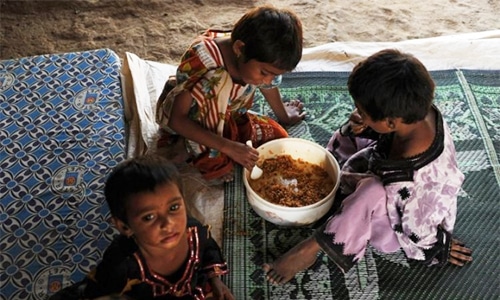ISLAMABAD: Four agencies of the United Nations on Friday warned of a colossal human loss to Asia and the Pacific and their economies if the countries concerned do not recommit themselves to ending all forms of malnutrition and achieving zero hunger by 2030.
The report — Asia and the Pacific Regional Overview of Food Security and Nutrition, published by the Food and Agriculture Organisation of the United Nations (FAO), the UN Children’s Fund (Unicef), World Food Programme (WFP) and the World Health Organisation (WHO) — highlights challenges that threaten to undermine the Sustainable Development Goal to end all forms of malnutrition by 2030 (SDG 2).
Nearly half a billion people (486 million) in Asia and Pacific region accounts are undernourished. While recently released global figures indicate an overall rise in the prevalence of hunger worldwide, returning to levels from a decade ago, this regional report points out that stagnation in combating hunger and malnutrition in Asia and the Pacific is also a major concern due to the large numbers of people involved.
Report highlights challenges that threaten to undermine the Sustainable Development Goal to end malnutrition by 2030
South Asia continued to witness some progress in reducing the number of undernourished people, although clearly not sufficient to achieve the zero hunger by 2030. In South Asia, the number of undernourished people declined by less than a million between 2016 and 2017.
Multi-country analysis in Afghanistan, Bangladesh, India, Nepal and Pakistan confirmed the primary importance of both good maternal nutrition and appropriate child feeding practices with timely introduction of diverse complementary foods. But in Pakistan only 4pc of children were getting a “minimally acceptable diet,” report said, citing a government survey.
The Asia-Pacific region is home to more than half of the world’s malnourished children. Malnutrition covers a broad spectrum and affects people of all ages — ranging from severe under-nutrition to overweight and obesity — but children in particular, continue to bear the burden. In this region, 79 million children, or one child in every four below the age of five, suffer from stunting and 34 million children were wasting, 12 million of who suffer from severe acute malnutrition with drastically increased risk of death. While some significant progress has been made towards a reduction of stunting, there has been little improvement in wasting during the past decade.
This is the first time that the four UN agencies responsible for helping countries in Asia and the Pacific achieve food security, improve maternal and child health and welfare, have jointly published such a report. Their joint efforts underline the urgency of the present situation and represent a united front and call to action in urging governments to show greater resolve in meeting previous commitments to end hunger and improve food security and nutrition across the region.
The report’s findings observes: “What is becoming increasingly clear is that the world cannot meet the 2030 target of zero hunger if Asia and the Pacific — the world’s most populous region — is not leading the way. It is a hard reality but one that must be faced with a united determination to turn things around”.
The report concludes with a cautious note of optimism. “Together, we hope that the findings of this report will contribute to a more informed dialogue. Without doubt, all stakeholders must make much greater efforts to accelerate progress toward the goals of a healthy and hunger-free Asia and the Pacific but their action is needed now. The sense of urgency cannot be overstated”.
Asia-Pacific region has witnessed rapid growth in the number of overweight children and the serious consequences that entails for their future health and well-being. An estimated 14.5 million children under the age of five are overweight and virtually all children in the region are increasingly exposed to cheap, unhealthy processed foods high in salt, sugar and fat but poor in essential nutrients. “This double burden of malnutrition sees undernourished and overweight children living in the same communities and households and it can even occur within the same child,” the report said.
Incidences of climate-related disasters have been rising in the region. Natural disasters impact food security and nutrition through reduced food production, which can then cascade down to the entire food value chain, affecting livelihoods and causing economic and agricultural loss. Beyond the short term, disasters can impact the agriculture sector through loss of assets and rural infrastructure, and through increased disease outbreaks. According to recent FAO estimates, Asia suffered a staggering loss of $48 billion during 2005-2015. Countries need to adapt agriculture to become more resilient to climate related events and to mitigate the damage they can cause.
Published in Dawn, November 3rd, 2018













































